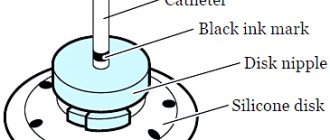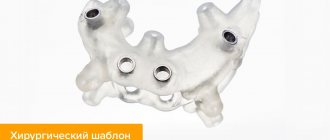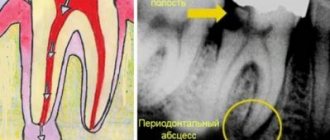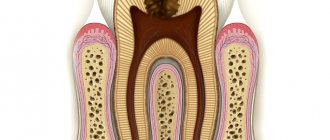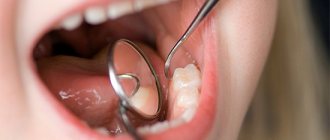Dental granuloma is an inflammatory formation at the apex of the root. It is a proliferation of granulation tissue. Granuloma is formed as a result of the action of protective mechanisms in which the body localizes the source of infection and seeks to isolate it from other tissues. According to ICD-10, the disease was assigned code K04.5.
Typically, a granuloma is formed against the background of inflammation of the neurovascular bundle - the pulp. If pulpitis is not treated, its root part becomes inflamed, and the infection spreads beyond the boundaries of the tooth, into the peri-root tissue. As a result, a kind of pouch is formed, filled with decay products of dead cells.
A granuloma is considered to be a formation up to 0.5 cm in size, but it can grow, and as it grows, it transforms into a cystogranuloma, the size of which reaches 1 cm. With a diameter of more than 10 mm, we are talking about a tooth root cyst. There is no cavity in a granuloma; it is an area of tissue surrounded by a capsule. Due to the latter, the granuloma is firmly attached to the apex of the tooth root.
Reasons for the development of pathology
There are two reasons for the development of granulomas on the root of a tooth.
1. Untreated pulpitis. The development of caries leads to the appearance of a deep cavity in the tooth. Pathogenic microorganisms enter the pulp, it becomes inflamed, and severe pain appears. Lack of medical care leads to the gradual death of the pulp. Bacteria penetrate beyond the tooth through root canals. A focus of inflammation appears at the apex of the root. We are talking about periodontitis.
A deep carious cavity in this case is not always observed. Inflammation can develop internally when secondary caries appears under the filling.
2. Poor quality endodontic treatment. Granuloma can develop at the root of a tooth in which root canal filling was previously performed. Usually there is underfilling: the doctor has not completely filled the canals with material. In the remaining voids, pathogenic bacteria develop, and the tissues surrounding the root react with inflammation.
These causes cause most cases of granuloma formation. But there are others, less common:
- poor quality orthodontic treatment;
- previous dental trauma;
- other inflammatory diseases - tonsillitis, abscess, etc.
In the latter case, the infection enters the tissues through the blood or lymph flow.
Ask a Question
Causes of dental granuloma
Pathological changes in the periodontium that violate its integrity are possible triggers for the formation of granulomas. In this case, the root cause is bacteria, in response to which cells of the immune system (phagocytes) migrate to the infectious-inflammatory focus. It is important to note that the infectious-inflammatory process in the periodontium can be caused by various dental diseases and conditions. Often these are caries, pulpitis and periodontitis.
If caries is not treated in the initial stages, the disease progresses. Pathogenic bacteria that produce acids destroy the hard tissues of the tooth, reaching the pulp. This is how pulpitis develops, in which the pathological process can reach periodontal tissue.
The following factors contribute to the development of granulomatous periodontitis:
- The appearance of microcracks in the teeth, through which it is much easier for infections to enter the periodontal tissue.
- Poor oral hygiene. In addition to brushing your teeth twice, it is also necessary to rinse your mouth after eating. And don’t forget about preventive examinations with a doctor every 6 months.
- Incorrect treatment of gum and dental diseases. In particular, this is insufficient antiseptic treatment after conservative or surgical treatment.
- Malfunctions of the immune system. An indirect sign of this is frequent colds. This suggests that the body is unable to resist pathogens.
- Bad habits, in particular smoking.
- Hypovitaminosis. A lack of biologically active substances and minerals leads to disruption of the immune system, as well as deterioration of the condition of gums and teeth.
Granuloma symptoms and complications
Symptoms of dental granuloma are nonspecific. Often the patient is unaware of the disease, since there may be no signs at all. Usually the tooth does not bother you, but moderate pain occasionally occurs when biting, drinking hot drinks or eating food. Such symptoms are characteristic of all forms of periodontitis.
It is worth noting that from time to time the disease may worsen. For example, in case of hypothermia, an infectious disease, surgery - in all cases when the body's defenses are reduced. During an exacerbation, the following symptoms appear:
- sharp pain, intensifying when biting, tightly closing the jaws;
- swelling of the gums in the projection of the root apex;
- pain in the gums when touched.
An exacerbation can go away on its own, and the disease returns to its chronic form. But sometimes inflammation develops before the appearance of purulent contents in the tissues - periostitis or gumboil.
Inflammation can cause resorption or dissolution of a section of jaw bone tissue. The appearance of purulent complications is dangerous due to its consequences: from tooth loss and damage to surrounding units to tissue melting and sepsis. Therefore, it is important to get timely help from a doctor. Treatment of dental granulomas is carried out by a dental therapist, and if removal is required, you need to contact a dental surgeon.
Why is granuloma on the root of a tooth dangerous?
Infectious and inflammatory processes in the oral cavity are dangerous for the spread of infection to other parts of the body. If granulomas are not treated, there is a risk of developing the following conditions:
- Destruction of the tooth root, which requires extraction.
- The appearance of abscesses in the tissues surrounding the jaws.
- Purulent periostitis (flux).
- Formation of cystic granulomas and cysts in the jaw areas.
- Cellulitis is a purulent inflammation that does not have defined boundaries (unlike an abscess).
- Sepsis is a generalized infection of the body.
- Infectious and inflammatory lesions of the brain (encephalitis, meningitis).
- Inflammation of the sinuses (sinusitis).
- Infectious and inflammatory damage to internal organs (pyelonephritis, myocarditis and others).
Conservative treatment
For granulomas, conservative treatment is more often used. It consists of mechanical treatment of the root canals. After this, they are filled with temporary healing material - pastes based on calcium hydroxide. After 2-3 weeks, a control image can be taken, and if the inflammation is eliminated, the canals are filled with a permanent material - gutta-percha. A new permanent filling is placed on the crown of the tooth.
There are two treatment tactics depending on the initial condition of the tooth.
1. Treatment of granuloma of a tooth in which the root canals are not filled. In this case, treatment involves the following steps:
- removal of carious tissues, old filling on the crown, if any;
- mechanical treatment of canals - with the help of special tools they expand, the walls are smoothed;
- antiseptic treatment of canals.
Further actions depend on the size of the granuloma. If it is small, up to 3 mm, simultaneous filling is allowed. If the formation is more than 3 mm, then the root canals are filled with temporary paste. It helps the granuloma shrink or disappear completely.
You will have to wear temporary material for no more than 3 weeks. At the end of the period, the doctor will order a repeat x-ray, and if he sees positive dynamics, he will fill the root canals with permanent material. The restoration of the tooth crown is also carried out.
2. Treatment of a tooth in which the root canals have already been filled. In this case, the doctor will first remove the old material. If a tooth has a crown, it must be removed. The root canals must be resealed, and the treatment tactics correspond to those described above: sometimes the installation of a temporary therapeutic filling is required.
Tooth granuloma: what is it?
Granuloma is a nodular inflammation that occurs as a result of the proliferation and transformation of cells capable of phagocytosis - the absorption of foreign microorganisms. Dental granulomas usually result from an infection. Initially, a node appears at the site of the lesion, and then it turns into a kind of sac with purulent contents. This is a dental granuloma. The mechanism of the appearance of granuloma is not yet fully understood, but 4 main stages of this process are known:
- Cluster of phagocytes . Phagocytes accumulate at the site of the lesion. These are specific cells of the immune system that absorb foreign particles (for example, bacteria that attack the gums). At the first stage, these are still immature (young) phagocytes, which subsequently specialize.
- Macrophage formation . Young phagocytes mature into macrophages. These are specialized phagocytes that are unable to move long distances, but are focused on performing tasks in a specific location (for example, the oral cavity). This is how a macrophage granuloma forms in the tooth.
- Formation of epitheloid granuloma . The process of transformation of immune cells (young phagocytes and macrophages) continues. They form into epitheloid cells and form an epitheloid granuloma of the tooth.
- Final formation of granuloma . Subsequently, the epitheloid cells fuse to form giant cells. This forms a granuloma, the diameter of which is about 1-2 mm. Over time, the nodule increases in size to 5-8 mm or more.
Important! At the initial stages, such formations are invisible.
They do not cause discomfort, so a person is not able to identify them. Granulomas are noticeable in the initial stages only on an x-ray. Often such formations in the initial stages are discovered by chance, when the patient is given an x-ray for another reason. When we talk about dental granuloma, we mean nodular formation of the periodontium. This is connective tissue located between the cementum of the dental root and the plate of the dental socket (alveoli). Therefore, the second name of this disease is granulomatous periodontitis.
In other words, dental granulomas are a form of periodontitis. Moreover, in the case of granuloma, active inflammatory processes (characteristic of periodontitis) are replaced by a proliferative process (tissue proliferation and active cell division). It is the absence of inflammatory phenomena that is associated with the long asymptomatic course of the disease. Symptoms in this case occur only at the acute stage, during which pain, swelling, redness of the gums and other noticeable phenomena occur.
Most often, granuloma in the mouth is located in the upper part of the tooth root. Depending on the location, the following types of these neoplasms are distinguished:
- Apical . This is the most common option, in which the tumor is located at the apex of the tooth root. As they develop and grow, apical granulomas can turn into cysts.
- Interroot . Such granulomas are located between the roots of the tooth. Such neoplasms are characterized by a sluggish clinical picture. The asymptomatic period with interradicular granulomatous periodontitis can last until tooth destruction. For this reason, tooth extraction is resorted to for treatment due to the impossibility of conservative therapy.
- Migratory . In this case, a granuloma forms in the subcutaneous tissue area. Another name for migratory granuloma is odontogenic. As in the case of interradicular granuloma, migrating granuloma is sluggish.
- Desnevaya . Granulomas on the gums develop both against the background of diseases of the tooth and gums, and during injuries.
Surgery
Surgical treatment of dental granuloma may be required only in a few cases:
- obstruction of the root canals - complex, tortuous structure, too thin, narrow canals;
- impossibility of unsealing channels;
- the presence of a pin in the root canal - attempts to remove it may cause injury;
- patient's reluctance to remove the crown.
Many patients prefer granuloma removal because they do not want to resort to long-term treatment and remove a good crown. In this case, an apical resection operation is performed - part of the root is removed along with the granuloma through a small incision in the gums. Less commonly used is hemisection - removal of one root of a multi-rooted tooth along with part of the crown. In this case, further restoration of the crown of the tooth with a prosthesis will be required.
In rare cases, it is not advisable to preserve a tooth with granuloma. For example, if the crown is severely damaged and cannot be restored. In this case, when removing a tooth, the doctor must remove the granuloma from the socket in order to prevent the development of inflammation.
If purulent complications develop against the background of a granuloma, it is important to get help from a doctor immediately. The specialist will provide first aid: relieve acute pain by opening the tooth. Previously sealed canals are opened, and purulent contents are subsequently removed through them. In this case, relief comes instantly.
If severe swelling of the gums or cheeks appears, this may be due to the release of inflammatory contents under the periosteum or oral mucosa. In this case, a small incision is made to drain the pus. Further treatment is possible only after relief of acute symptoms. Drug therapy will also be required - the doctor will prescribe a course of antibiotics. You should not take them on your own. Moreover, it makes no sense to be treated only with antibiotics in the hope that the inflammation will go away - they are not able to eliminate the source of the disease or even reduce it, it is important to take local measures to eliminate the inflammatory process.
General information
Pyogenic granuloma is conditionally classified as a group of pyoderma , because previously it was believed that the provoking factor was a staphylococcal infection , but now it is defined as benign inflammatory hyperplasia of granulation tissue.
The pathology is usually localized on the skin of the feet, hands, red lip border, on the abdomen, oral mucosa, periungual ridges, in places of cuts, injections, burns, splinters, ingrown nails , in extremely severe cases in the gastrointestinal tract and is most often single.
Features of prevention
The main condition for the prevention of dental granulomas is timely assistance from a dentist when caries occurs. You should not allow severe tooth decay or the development of pulpitis. The peri-root tissues are healthy until the pulp becomes inflamed. Therefore, if symptoms of caries or pulpitis appear, it is important to immediately consult a doctor.
Endodontic treatment also increases the likelihood of developing periodontitis. Therefore, it is better to eliminate caries in the early stages and avoid the need for root canal filling. If this is unavoidable, it is important to carefully choose a dental clinic - the professionalism of a specialist will help eliminate possible mistakes and prevent complications.
Pathogenesis
Typically, pyogenic granuloma, also called telangiectatic granuloma, occurs at the site of a minor skin injury, such as a scratch or abrasion. The formation process is quite fast - it begins 1-2 weeks after a minor scratch and is benign; it can be tumor-like, granulomatous, rising above the skin and forming a structure the size of a lentil grain, cherry bone or nut.
The formation of pyogenic granuloma occurs in several stages:
- phagocytes accumulate in the area of minor injury ;
- then the transformation of cellular structures into macrophages and degeneration into granuloma occurs;
- Subsequently, an epithelioid pyogenic tumor is formed due to the transformation of macrophages and phagocytes into epithelioids, which additionally gives it the properties of a granuloma.
The structure is usually represented by granulation tissue in the form of an atypical proliferation of numerous small capillaries ( angioblastoma ), inflammatory infiltrate and endothelium; in later stages it can become lobulated. Then a regression stage is possible due to extensive fibrotic processes.
In most cases, botryomycoma occurs at the site of minor injuries, however, it can also occur without previous trauma; in this case, elevated tumor-like formations of a bright red or bluish color develop, which contain a large number of superficially located vessels, which gives it the features of a lobulated capillary hemangioma. Ulceration and damage to the tumor entail an increased risk of secondary infections and recurrent inflammation. It is important to remember that any benign neoplasm can degenerate into malignant.
Pyogenic granuloma in children
The prevalence of pyogenic granuloma among children and adolescents is quite high. It is very important that parents conduct regular visual examinations of the skin and mucous membranes of children and contact a specialist if they identify any papule-like or nodular formations of a conical, raised shape, as well as changes in pigmentation and growth of moles.
For children, a separate danger from botryomics is increased bleeding of the neoplasm, erosiveness and the addition of a bacterial infection, up to blood poisoning. Therefore, it is very important that the child knows the basic rules of asepsis and immediately contacts adults in the event of the slightest traumatic incident.
Botryomycomas are detected quite easily in children, because they are usually located on the hands, soles, face and lips, have a characteristic appearance and rapid growth.
Description of PG
Clinically, PG is a soft or dense, tumor-like nodule with a smooth or lobulated surface, pedunculated, does not cause pain, the diameter of PG varies from 0.5 to 2.0 cm, the color is dark red. A stalk with a “collar” of exfoliated epithelium, a stalk of different lengths, sometimes the PG resembles the shape of a mushroom. After PG appears on cuts, burns, injection sites, abrasions, etc. after several weeks or months, PG quickly increases in size, acquires a dark color and becomes dense.
Initially, the surface of the PG is moist, vascular, raspberry-like, covered with erosion, crust, and bleeds even with mild irritation. Often, when PG appears, a secondary infection is added; ulcers, necrosis, and bloody and purulent discharge form on the surface of the granuloma. Removing PG is painless. In most cases, the granuloma is single; less often, multiple neoplasms are observed, which form against the background of extensive burns and injuries. Mostly, PG is formed on the hands, fingers, feet, face, less often on the genitals, eyelids and tongue. In almost 50% of cases, PG is found at the site of an ingrown toenail and is considered a common complication of this disease. Giant PGs, ranging in size from 3.0 to 5.0 cm or more, are a rare occurrence according to statistics, but in ordinary life they are found quite often at the sites of bedsores.
